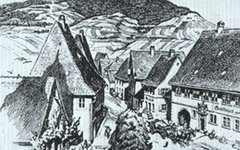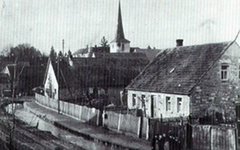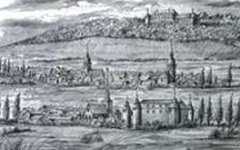
The name “Rödelsee” is misleading; it has nothing to do with a lake or pond (“See” in German), despite the idyllic village pond, a remnant of the moat of the old castle, which fell into ruin after 1600. Place names like Rotelse or Rädelsa came into being in the 6th/7th centuries, when the Franconians settled in the region. The colonized land had to be protected by military bases. The local settlement was named Rodelsheim or also Rotelse after its leader, a certain Rodilo or Rotel; this is the origin of today’s name Rödelsee. The village was first mentioned in a document in 1040, in connection with Kitzingen Abbey.

Stockheim, first mentioned in 1220 with reference to the knight Albrecht Fuchs von Stockheim, is a late Franconian woodland clearance settlement. The settlers worked hard to fell trees and remove the stumps (“Stock” in German). To distinguish this place from others with the same name in the vicinity, “Frosch” (frog) was first added to “Stockheim” in a document in 1412, probably because plenty of frogs lived here in the swamps. The village fountain with a water-spouting frog, put up in 1962, is a humorous reminiscence of the original name Frosch-Stockheim, which became Fröhstockheim later on.

The name “Swaneberk”, documented in 1230, indicates that this is a mythical hill, where the Celts not only built a large refuge fort, but also sacrificed to the goddess Svana. Their Germanic successors also gave offerings to the goddesses of destiny, thought to be swan women or swan maidens, at the hilltop. Schwanberg has always been a holy hill, even today as the location of Communität Casteller Ring, a Lutheran nunnery. Legend has it that a castrum, or fortification, which was once the centre of the region, existed here as early as 750, in the reign of Franconian King Pippin. The fact that a V-shaped ditch on Chapel Slope (Kapellrangen) separated the front area, on which St. Walburga’s Chapel was later built, from the back of the hill suggests there once was a Carolingian fortification. This ditch, discovered by archaeologists in 1985, was 10 metres wide and 1.5 metres deep. However, it was not until 1258 that the construction of a castle was mentioned in a document, referring to Heinricus Vulpes (= Fuchs) aduocatus de Swanenberk (= Governor of Schwanberg).
Aktuelles
Alle wichtigen Nachrichten und Meldungen der Gemeinde Rödelsee!
Anfahrt und Lage
So finden Sie zu uns
Erweiterte Suche
Sie haben eine Veranstaltung, einen Verein oder eine Firma gesucht?
Dann nutzen Sie bitte unsere spezielle Suche in den jeweiligen Rubriken.










